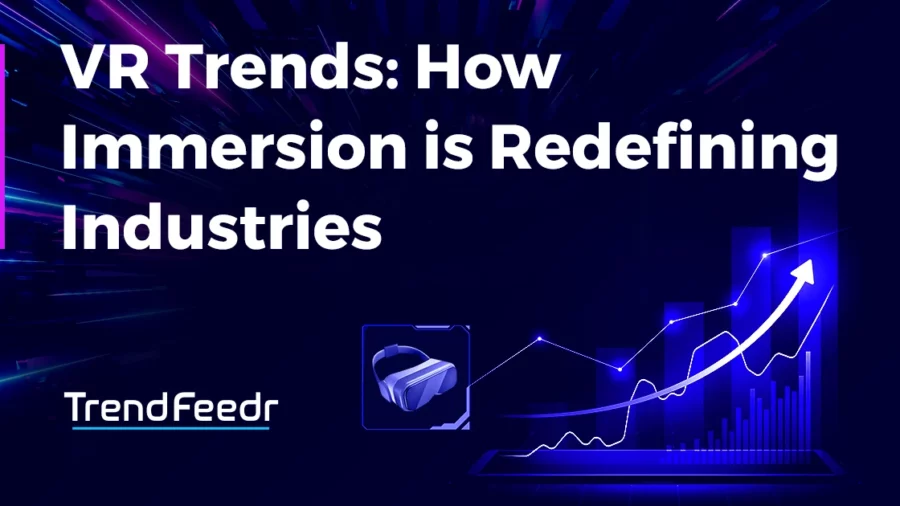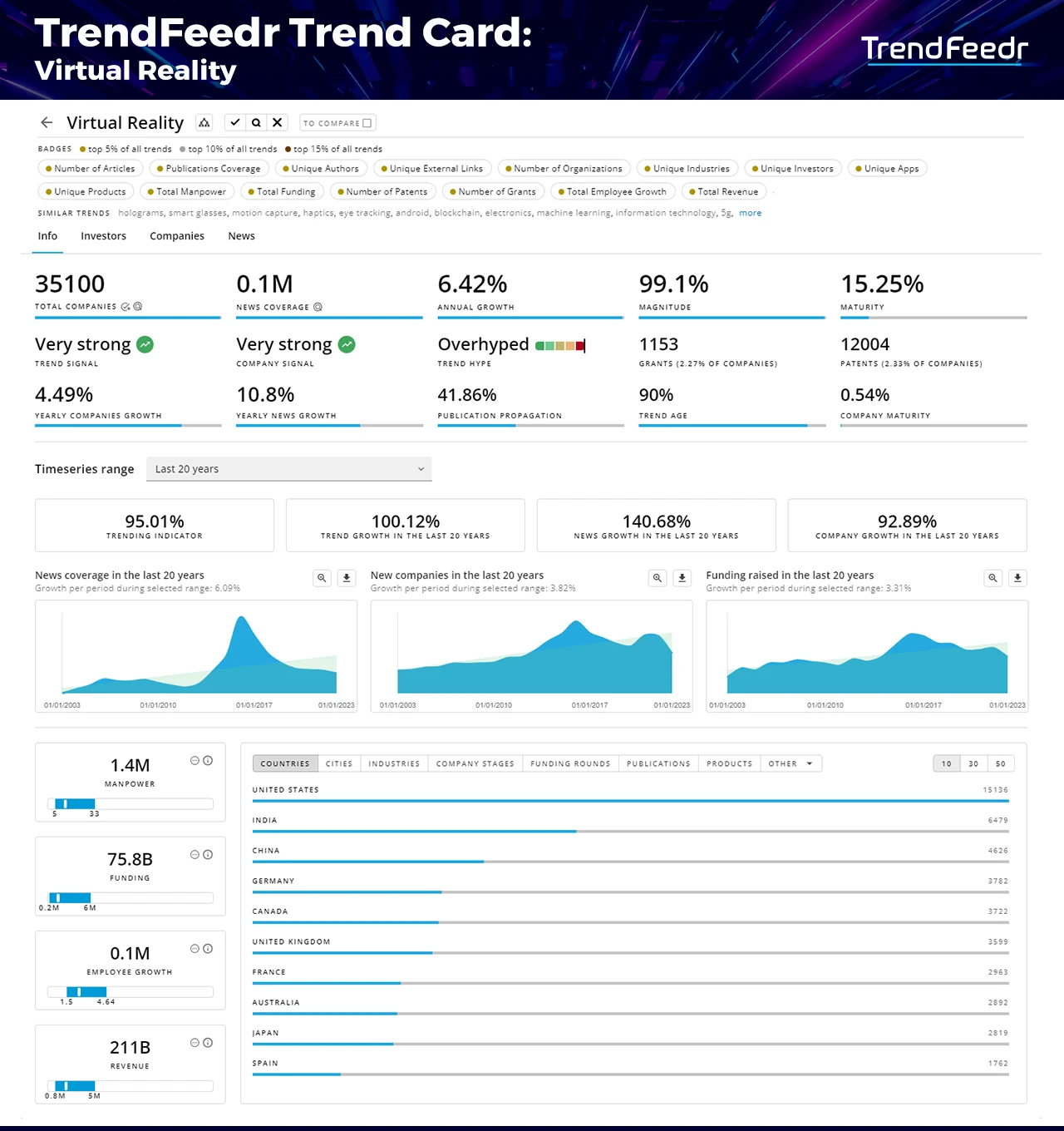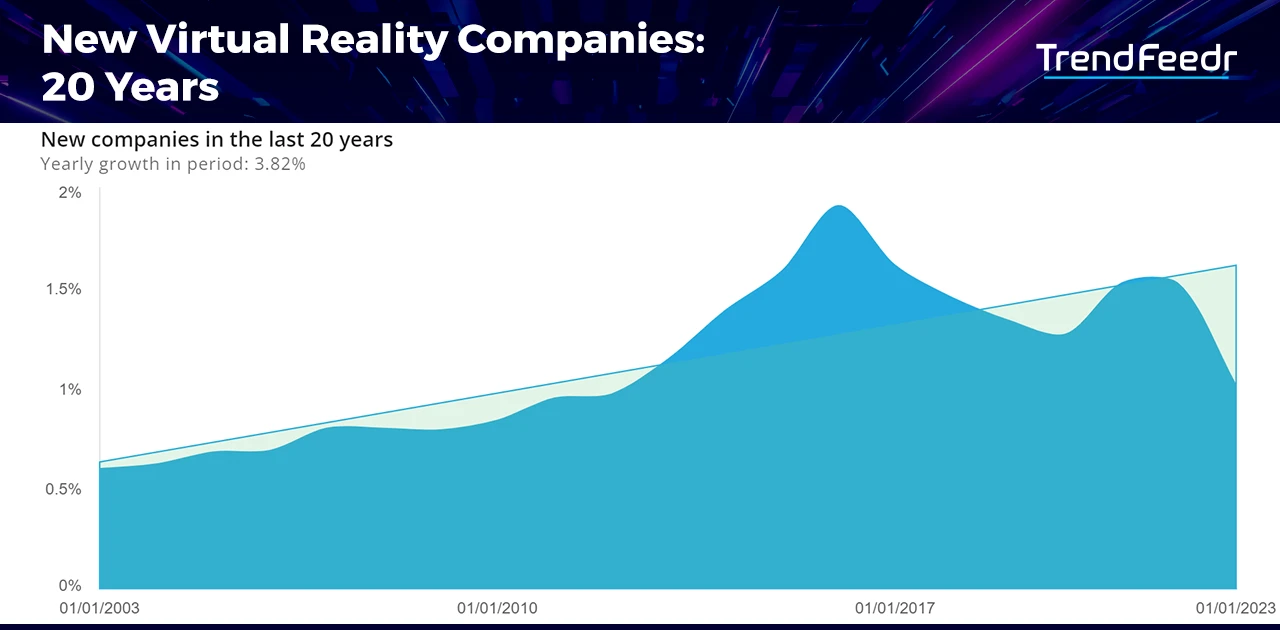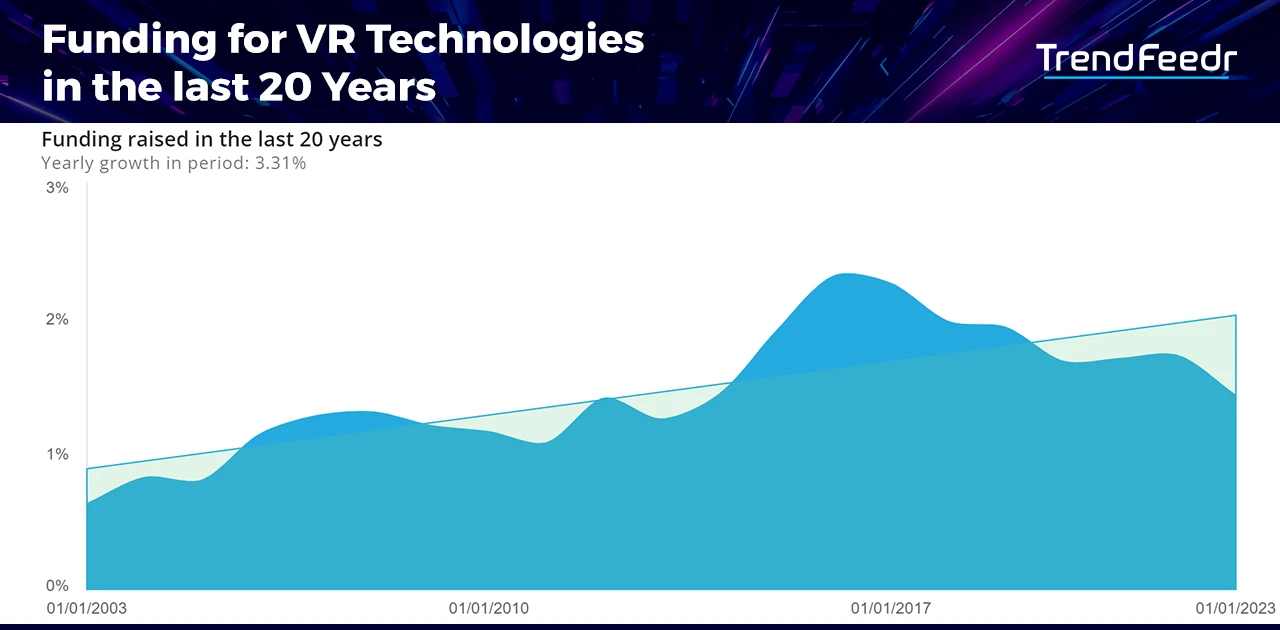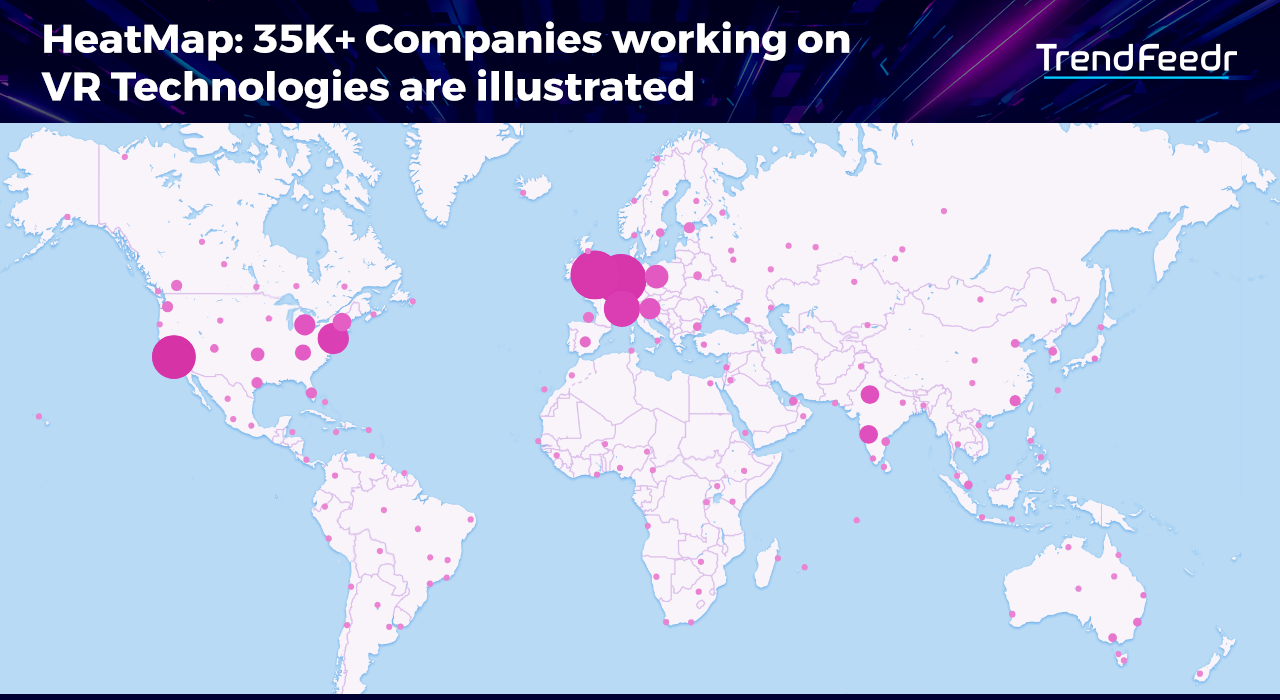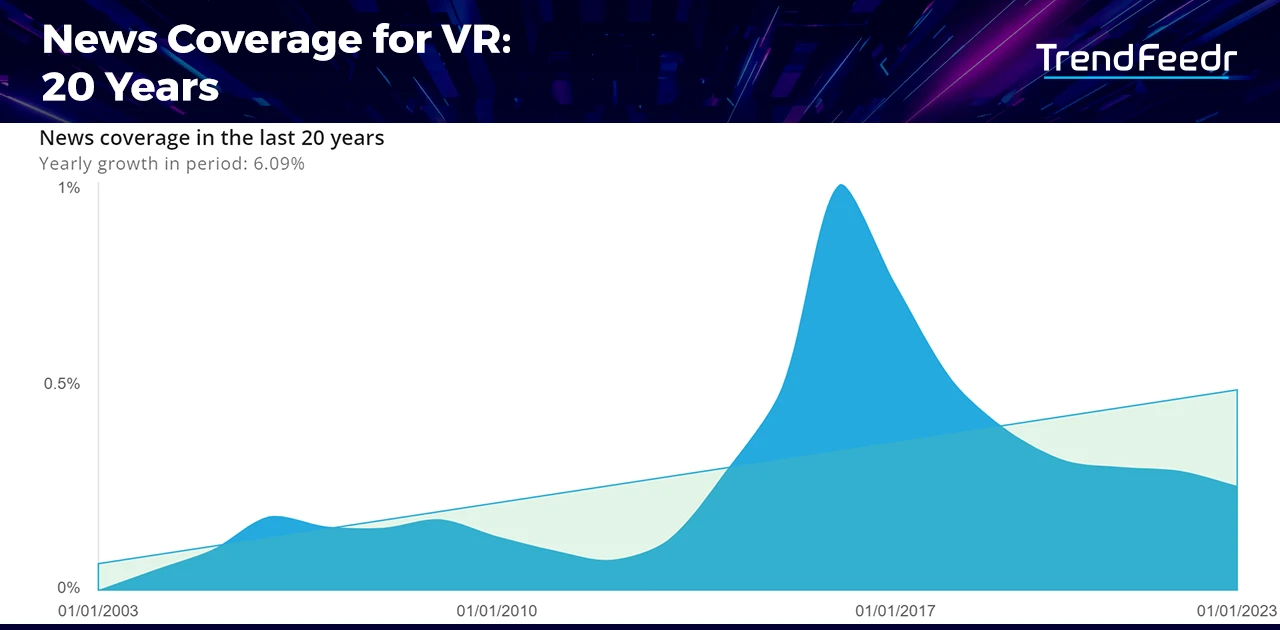Virtual Reality (VR) has evolved beyond its initial allure of captivating 3D video games and immersive cinematic experiences. Today, VR trends are a powerful catalyst, instigating change in businesses and industries worldwide.
Statistical reports further underscore the growing influence of VR. According to the ARtillery Intelligence report, VR will reach 25% of internet users in the US by 2023. According to the Oberlo report, there is an anticipated seven-fold increase in global VR and AR device shipments, hitting 43.87 million units by 2025 from 2020. Businesses are also leveraging VR, especially in training programs. Data from the Front Core reveals that VR training has a retention rate of 75%, outperforming lectures (5%), reading (10%), and audio-visual learning (20%). Additionally, the use of VR in training reduces the occurrence of workplace injuries by 43%.
A report from Fortune Business Insights anticipates significant growth in the VR market, projecting that it will expand from US$25.11 billion in 2023 to US$165.91 billion by 2030.
As the lines between the digital and physical worlds blur, VR emerges as a key influence, reshaping how businesses operate, innovate, and connect with their audience.
Key Takeaways
- Rising Digital Realm: With a trend magnitude of 99.1% and a trend maturity of 15.25%, VR is asserting itself as a transformative domain in the tech industry.
- Multifaceted Applications: Companies in this sector are expanding their scope by incorporating current trends in VR such as holograms, smart glasses, motion capture, haptics, and eye tracking.
- Persistent News Coverage: The consistent growth of 6.09% in news coverage over the past two decades underscores VR’s growing significance in both tech and mainstream conversations.
- Venture Attraction: Approximately 35,100 entities are venturing into the VR landscape, collectively amassing an investment pool of around US$75.8 billion.
- Funding Powerhouses like Tencent, Temasek Holdings, and Andreessen Horowitz are leading the funding drive, directing millions into innovative VR projects.
- Innovation Epicenters include countries like the United States, India, China, Canada, and Germany, with cities such as London, New York City, Los Angeles, San Francisco, and Bangalore emerging as the epicenters for VR innovation and commerce.
Table of Contents
- Understanding VR Trends
- VR Trend Performance Analysis
- Key VR Trends & How Companies are Advancing Them
- How does VR disrupt industries?
- VR Investment Trends
- Geographical Activity of VR Companies
- Future Outlook of VR Trends
In this data-driven report, we delve into the current trends in virtual reality, including holograms, smart glasses, motion capture, haptics, and eye tracking.
We utilize TrendFeedr, our all-in-one trend intelligence platform, for this comprehensive analysis of virtual reality trends. TrendFeedr employs advanced algorithms to identify future industry and tech trends. With an emphasis on trend discovery and analysis, the AI-powered platform reviews thousands of trends each week to provide actionable insights.
Out of the more than 20,000 trends and technological advancements that TrendFeedr keeps track of, Virtual Reality (VR) is a standout. Here’s why:
- VR distinguishes itself by being in the top 200 and ranking in the top 1 percent of global trends, highlighting its accelerating adoption rate.
- With a trend maturity of 15.25%, VR’s emerging presence is evident, reflecting the increasing number of nascent companies delving into the technology.
- Its wide reach and pivotal influence underscore its role in driving next-gen virtual interactions and solutions. These VR solutions are being used for training, product design, and customer engagement.
The following sections of this report explore various aspects of VR trends. Discussions will include performance analytics, evolving investment landscape, patterns of regional adoption, and future outlook.
Understanding VR Trends
In the rapidly advancing field of VR, both technological innovation and real-world applications are evolving at a remarkable pace. Let’s take a look at the current trends and technologies in VR and the science behind them.
What is the technology behind VR?
VR creates an immersive digital experience by simulating our real-world senses. The display technology in modern VR headsets uses OLED or AMOLED displays. These are preferred for their low persistence properties, which help reduce motion blur. To mirror users’ movements in the virtual environment, tracking systems like six degrees of freedom (6DoF) are used.
Such systems track movement in all directions. Additionally, VR employs binaural or 3D audio to mimic real-world sound cues. This provides a spatial sense of direction and depth to the audio sources in the VR environment.
What is trending in VR?
In the realm of VR, several exciting advancements are shaping the future. Adaptive haptics, a technology that enhances tactile feedback in VR devices, allows users to experience sensations like texture, temperature, and resistance. This makes the virtual world feel incredibly real. Take TESLASUIT for example, it merges haptic feedback, motion capture, and biometrics to facilitate a full-body sensory experience in VR.
Neural interfaces are another breakthrough, bridging the gap between the mind and machine. This technology allows users to control VR environments with their thoughts, ushering in a new era of interaction within virtual spaces. OpenBCI’s Galea is one such example. This headset is outfitted with an array of sensors, including EEG (electroencephalography) and EMG (electromyography). The EEG sensors capture the electrical activity of the brain while the EMG sensors monitor the electrical activity of nerves and muscles. These sensors empower users to navigate their VR experiences using their brain waves and facial muscle movements.
Lastly, extended reality (XR), which combines VR, augmented reality (AR), and mixed reality (MR), provides an integrated experience that blurs the lines between reality and digital simulations. A prime example of this is KIA’s innovative VR showroom, allowing customers to explore new vehicle models in an immersive environment.
VR Trend Performance Analysis
Introducing the VR Trend Card—a guide that provides a comprehensive view of the virtual reality landscape. This meticulously curated snapshot highlights the trailblazing entities and investors shaping the future of VR. Discover the sectors leveraging VR’s capabilities, delve into timely journalistic insights, and understand the investment momentum driving it. It gives you insights into VR’s impressive growth trajectory and the crucial role media plays in its promotion. Keep reading as we delve deeper into the subsequent sections and position yourself at the forefront of VR’s digital revolution.
Experiencing an annual growth of 6.42% and boasting a trend magnitude of 99.1%, VR is instigating a seismic shift in the tech industry. This trend holds a position in the top 1 percent of all trends, underscoring its rapidly expanding influence. With a trend maturity of 15.25%, VR has certainly matured as a technology. However, the potential of VR is vast, and we are only just beginning to scratch the surface.
Looking for all trends related to virtual reality?
Key VR Trends & How Companies are Advancing Them
Data from TrendFeedr reveals that 35,100 organizations working with VR are also actively participating in related emerging trends. Let’s explore these trends in more detail:
Holograms
- These projections create 3D images that appear lifelike and stunning in VR. Moreover, holographic technologies enable interactions with projections and control of virtual designs.
- A total of 2,162 organizations have recognized the transformative capabilities of this technology in immersive applications, collectively securing US$4.1 billion in funding.
- Further, a force of 70,000 experts is pushing the boundaries of holographic technology.
Smart Glasses
- These devices combine AR and VR to create immersive experiences that users can wear.
- 1,651 organizations have recognized the potential of this technology across VR, AR, and XR applications, securing an astounding US$9.6B in funding.
- A strong pool of 100,000 specialists is driving innovation in this wearable tech sector.
Motion Capture
- This technique translates real-world movements into digital animations, making VR more dynamic and authentic.
- To enhance user interactions, 1,507 organizations are pursuing this trend, collecting US$4.2 billion in backing.
- A network of 74,000 professionals is ensuring the accuracy and quality of motion capture in VR and XR.
Haptics
- This technology adds a sense of touch to VR, making it more realistic and engaging. Combining haptic feedback allows delivering a full-body sensory experience in VR.
- The trend has been supported by 1,149 organizations, which have secured US$4.4 billion in investment.
- A team of 47,400 experts is working hard to make virtual interactions as natural as possible.
Eye Tracking
- Eye tracking enhances the user interaction in VR by responding to their gaze direction. It increases their engagement as well as their sense of presence.
- It has been explored by 892 organizations, which have received US$1.6 billion in funding.
- Moreover, a group of 26,500 professionals is advancing eye-tracking technology in the metaverse.
As we progress, the incorporation of VR into our everyday lives will become increasingly prevalent, presenting both challenges and opportunities for consumers and industries alike.
How does VR disrupt industries?
The fusion of VR with diverse industries has sparked innovations and applications that were once only imagined in science fiction. From all-encompassing experiences to detailed simulations, VR’s influence is far-reaching across sectors. Let’s delve into the top industries reshaped by VR and their noteworthy applications:
Gaming
Without a doubt, the gaming industry is the most prominent sector where VR has made significant strides. It offers gamers an unparalleled level of immersion, transforming them from mere players to active participants in the gaming universe.
Games such as Half-Life: Alyx and Beat Saber have set new benchmarks in the VR landscape. They transport players into extraordinary realms and provide unmatched interactive experiences. These games exemplify the potential of VR, redefining the boundaries of gaming and setting a new standard for immersive entertainment.
Tourism
VR trends in tourism are offering a new dimension to travel. It is no longer about merely watching a video or browsing through images. VR allows travelers to dive into their desired destinations before they even set foot there. Through VR applications, users also embark on virtual tours of world-renowned landmarks, historical sites, and natural wonders.
For example, the Louvre Museum in Paris offers a VR tour of its celebrated art pieces. Moreover, innovative virtual reality travel startups provide personalized virtual experiences based on user preferences and interests, allowing them to virtually traverse various destinations.
Healthcare
The healthcare industry is increasingly utilizing VR for a wide range of applications, from medical training to patient therapy. This technology enables surgeons to rehearse intricate procedures in a safe environment while patients use VR for rehabilitation or pain management.
For instance, Osso VR provides a platform for surgical training, offering healthcare professionals the opportunity to practice procedures without any associated risks. Similarly, AppliedVR’s RelieVRx presents an immersive eight-week VR experience that allows patients to modify their cognitive, emotional, and physical reactions to chronic pain.
Real Estate
VR has ushered in a new era in the real estate industry, transforming house hunting and property tours into immersive and convenient experiences. This enables potential buyers or renters to explore properties from any location, offering a comprehensive perspective of the property without the necessity for physical presence.
RealSpace 3D, a company at the forefront of this technological revolution, provides a real-time, interactive platform that showcases and markets unbuilt properties. With the aid of a simple touch interface or full immersion via a VR headset, customers fully experience any environment. This innovative approach allows prospective buyers to undertake a complete tour of a property before its actual completion.
Retail
Virtual shopping experiences enable consumers to ‘try before they buy’, from clothing to furniture, enhancing the online shopping journey. This allows customers to personalize their shopping journey and even feel the product.
Companies like Emperia enable brands to create a virtual retail store that mirrors their physical space. Its technology allows product placement in line with brand guidelines. The virtual store is integrated into online properties and metaverse platforms, serving as a standalone website or online storefront.
The convergence of VR with these industries signifies not just a technological transition, but a paradigm shift in how businesses engage with their customers and how consumers perceive the world.
VR Companies Leading The Way
Over the past two decades, there has been a consistent annual growth of 3.82% in organizations stepping into the VR sphere. This represents the confidence and commitment that businesses are placing in the transformative potential of VR. It also signifies the evolving trust in VR’s capacity to reshape our interaction with digital environments.
Further, VR startups are emphasizing deep immersion, instantaneous interaction, and flexibility, tackling the complex challenges of user experience, hardware compatibility, and content variety. By incorporating technologies such as haptic feedback, eye-tracking, and spatial audio, these companies are delivering a comprehensive digital experience. Here are a few virtual reality startups established in the last five years:
- RealityWell – An operator of a VR platform for seniors that crafts bucket list experiences, games to combat cognitive decline, and interactive immersive experiences.
- VR Coach – A developer of a VR coach smart system for therapy that includes interactive scenarios to address various phobias, addictions, and compulsions.
- VRpilot – It provides VR solutions specifically designed for professional flight training.
- Octonic – A VR startup that transforms treadmill workouts by transforming them into immersive fitness adventures within virtual worlds.
- Immersive Quest – The company develops a VR platform dedicated to healthcare professionals, offering an immersive training experience.
Redirecting to workforce expansion, the VR industry currently boasts an impressive global workforce of 1.4 million individuals. On average, each virtual reality company employs 54 individuals. Interestingly, the median number stands at 11, indicating a landscape where, in addition to industry leaders, a substantial portion of firms remains mid-sized, concentrating on specialized services. In terms of employee growth, the sector has seen an addition of 139.7K individuals, with the average company adding 6 new members to their team annually.
VR Investment Trends
When it comes to financial backing, VR with total funding figures lands in the top 5% among all 20K+ trends and technologies analyzed by TrendFeedr.
Remarkably, the virtual reality funding landscape has witnessed a modest yearly growth of 3.31% over the past two decades. This increase has significantly influenced the direction of technological advancements and the reach of VR within multiple industries.
A Closer Look at the Financials
Data from TrendFeedr highlights the substantial financial momentum VR has garnered. This sector has attracted a total funding of US$75.8 billion, with individual players like IMAX securing as much as US$801.2 million, and an average funding amounting to $14.7 million. On the revenue side, TrendFeedr estimates that the figure reaches a staggering US$211 billion, with some companies even generating revenues exceeding US$557.8 million.
When it comes to funding rounds in VR, five types stand out. Seed rounds ignite the birth of numerous innovative ideas. These are closely followed by early-stage VC/Series A rounds, indicating that latent potential investors recognize after the initial product-market fit. Venture rounds then supply the substantial capital necessary for scaling while later-stage VC/Series C ensures consistent growth trajectories for established firms. M&A rounds, on the other hand, represent strategic market consolidations and acquisitions.
Finally, it is worth mentioning the role of grants. A total of 1153 grants have been awarded, comprising 2.27% of VR companies.
Insights into VR’s Major Financial Backers
Tencent stands as one of the most significant investors in the VR domain, having invested US$1.2 billion across various VR initiatives. This company has diversified its VR investments across 15 ventures with a substantial portion of this investment, US$675 million, directed towards Skydance. Another noteworthy investment is the US$150 million into Pocket Gems, indicating Tencent’s strategic focus on mobile virtual experiences and gaming platforms.
Temasek Holdings, with a VR-focused investment portfolio worth US$814.5 million, has invested in six ventures. Among them, Magic Leap stands out with backing of US$502 million. Another significant investment of $87.5 million in Poshmark reflects their faith in the intersection of fashion and e-commerce, emphasizing virtual try-ons and customer interactions.
Andreessen Horowitz invested US$730.7 million across 15 enterprises, exemplifying a diversified approach to the virtual reality sector. A considerable portion of this fund, US$302 million, has been allocated to SkyMavis. Another significant contribution of US$75 million to Meta showcases the company’s support for a future where augmented reality and virtual reality converge, paving the way for immersive social platforms.
The public sector has also acknowledged the immense potential of VR, with public investments soaring to a commendable US$1.3 billion across 34 initiatives. Among these, IMAX received an investment of US$248 million, reflecting a belief in revolutionizing cinematic experiences through VR. Another substantial investment of US$172.9 million has been made in Appotronics, redefining projection and display technologies in a VR-centric future.
Moreover, the unique investors pouring money into VR places the trend among the top 5% of all trends, further proving its prominent position in the tech world.
Geographical Activity of VR Companies
The global distribution of the 35.1K companies integrating virtual reality into their operations is illustrated in the heat map below.
Interested to explore all 35K+ VR companies?
The United States leads the pack with its robust tech hubs and a culture that fosters innovation. Hot on its heels is China, demonstrating a remarkable upswing in VR advancements and applications. India, backed by its rapidly growing tech sector, is steadily establishing itself as a formidable player in the VR arena. Germany, known for its affinity for tech innovation, significantly shapes Europe’s VR landscape. Meanwhile, Canada has seen a more measured rise in VR prominence recently despite its strong tech foundations, suggesting shifting market dynamics and investment priorities.
On a more detailed level, cities serve as the epicenters of VR progression. New York City and Los Angeles are strongholds of innovation, attracting a multitude of VR startups and established firms to their territories. San Francisco, a traditional tech hub, is well-versed in the evolution of VR. Leading the charge in Europe’s VR initiatives is the dynamic city of London with its thriving VR ecosystem. In the East, Bangalore shines in India, acting as a crucible for VR developers, startups, and applications, thereby showcasing the city’s expertise in both software and emerging technologies like VR.
Media Coverage of VR Sees a Yearly Uptick of 6.09% Over Two Decades
Our line chart, which traces the trajectory of virtual reality news coverage over the past two decades, shows a steady yearly growth of 6.09%. The growth in publication coverage for VR trends is also noteworthy, ranking in the top 5% across all technological trends. Since 2005, an impressive 145,233 articles related to VR have been published, placing this trend in the top 5% of all covered topics up to 2023.
Future Outlook of VR Trends
Without a doubt, trends in VR are set to transform our digital experiences. Here are insights into the VR future trends:
Beyond Screens to True Immersion
As VR technology continues to evolve, the future is transitioning from mere visual immersion to a comprehensive sensory experience. This implies the incorporation of touch, smell, and even taste into VR realms, further blurring the line between the virtual and real world. Advances in haptic feedback enable users to experience virtual environments.
Mainstreaming of AR and VR Convergence
The likely convergence of AR and VR will lead to mixed reality experiences, allowing users to seamlessly transition between real and virtual worlds. This fusion of AR and VR will redefine user experiences. For instance, a user could begin by augmenting their real-world surroundings with digital information and, using the same device, switch to a fully immersive VR environment. This convergence will pave the way for new applications, particularly in areas like education, remote work, and social interaction.
VR in Workspaces
Remote work environments and virtual offices will see increased use of VR for enabling professionals to interact in immersive digital workspaces, thereby enhancing collaboration and productivity. The global events have already fast-tracked the adoption of remote work. With the introduction of VR, the concept of an office will undergo a transformation. Virtual meeting rooms, collaborative design spaces, and even virtual team-building activities will become the norm, ensuring that distance no longer hinders effective teamwork.
Democratization of VR Content Creation
VR content creation tools are set to become more user-friendly, empowering even those without a technical background to create VR experiences. As platforms become more intuitive and accessible, the VR landscape will witness a surge in user-generated content. This democratization implies that VR storytelling won’t be confined to big tech firms or gaming studios. Educators, artists, and amateur developers will also have the opportunity to shape the VR narrative.
Ethical Considerations and Regulations
With the advent of greater immersion and realism, ethical considerations regarding content, user data, and psychological impacts will gain prominence, leading to new regulations. The profound experiences offered by VR come with responsibilities. As users spend more time in virtual worlds, ensuring their mental well-being, privacy, and security will become paramount. The industry might see regulatory bodies stepping in to establish guidelines, ensuring that VR remains a safe and enriching space for all.
The horizon of VR is expansive and dynamic. These projected pathways, rooted in current trends and innovations, envision a world where the boundaries between the digital and physical are not just crossed but obliterated.
Navigating an Ever-Changing World
As we wrap up our journey through VR trends, it is clear that we are moving through a rapidly changing landscape. The pace of new discoveries is fast, and the range of possibilities seems endless. Keeping up with these changing trends is very important. It allows you to anticipate changes, take advantage of new opportunities, and stay ahead in a field that is shaping the future of technology. But how do you do that?
Connect with VR enthusiasts, industry leaders, and innovative creators; their insights can provide valuable perspectives and open up opportunities for collaboration. Dive into reports specific to the sector, attend VR-focused seminars and conferences, and participate in online VR communities. Also, consider using trend-tracking tools, like TrendFeedr, that meticulously track up to 297 sub-trends, offering a comprehensive view of the evolving VR landscape.
Committing to these activities will allow you to spot the latest trends in virtual reality, optimizing your investment strategies and business models.

